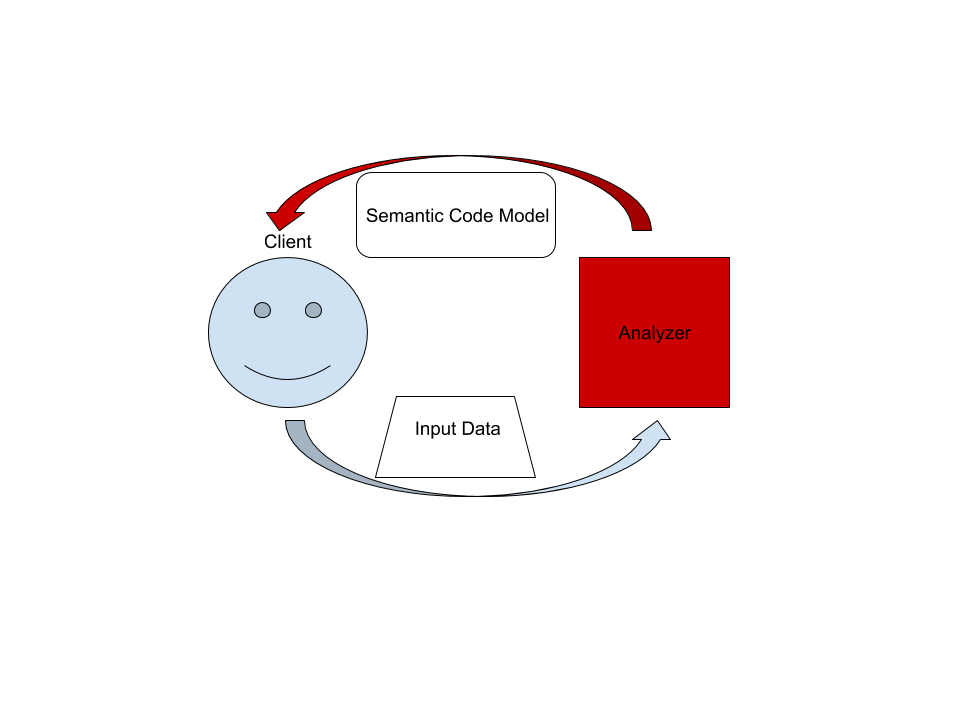diff options
| author | Aleksey Kladov <[email protected]> | 2018-12-17 21:13:50 +0000 |
|---|---|---|
| committer | Aleksey Kladov <[email protected]> | 2018-12-17 21:13:50 +0000 |
| commit | ee2dc9969fd46d710b7d17c297f3768f57a40e57 (patch) | |
| tree | 26011ecbaf6c28ef6202385ece9337f32b4ab260 /ARCHITECTURE.md | |
| parent | 620970b06e61b9380c668e3e5267c750b7cc4971 (diff) | |
big picture
Diffstat (limited to 'ARCHITECTURE.md')
| -rw-r--r-- | ARCHITECTURE.md | 29 |
1 files changed, 28 insertions, 1 deletions
diff --git a/ARCHITECTURE.md b/ARCHITECTURE.md index d31290483..3b200bbc8 100644 --- a/ARCHITECTURE.md +++ b/ARCHITECTURE.md | |||
| @@ -4,6 +4,33 @@ This document describes high-level architecture of rust-analyzer. | |||
| 4 | If you want to familiarize yourself with the code base, you are just | 4 | If you want to familiarize yourself with the code base, you are just |
| 5 | in the right place! | 5 | in the right place! |
| 6 | 6 | ||
| 7 | ## The Big Picture | ||
| 8 | |||
| 9 |  | ||
| 10 | |||
| 11 | On the highest level, rust-analyzer is a thing which accepts input source code | ||
| 12 | from the client and produces a structured semantic model of the code. | ||
| 13 | |||
| 14 | More specifically, input data consists of a set of test files (`(PathBuf, | ||
| 15 | String)` pairs) and an information about project structure, the so called | ||
| 16 | `CrateGraph`. Crate graph specifies which files are crate roots, which cfg flags | ||
| 17 | are specified for each crate (TODO: actually implement this) and what are | ||
| 18 | dependencies between the crate. The analyzer keeps all these input data in | ||
| 19 | memory and never does any IO. Because the input data is source code, which | ||
| 20 | typically measures in tens of megabytes at most, keeping all input data in | ||
| 21 | memory is OK. | ||
| 22 | |||
| 23 | A "structured semantic model" is basically an object-oriented representations of | ||
| 24 | modules, functions and types which appear in the source code. This representation | ||
| 25 | is fully "resolved": all expressions have types, all references are bound to | ||
| 26 | declarations, etc. | ||
| 27 | |||
| 28 | The client can submit a small delta of input data (typically, a change to a | ||
| 29 | single file) and get a fresh code model which accounts for changes. | ||
| 30 | |||
| 31 | Underlying engine makes sure that model is computed lazily (on-demand) and can | ||
| 32 | be quickly updated for small modifications. | ||
| 33 | |||
| 7 | 34 | ||
| 8 | ## Code generation | 35 | ## Code generation |
| 9 | 36 | ||
| @@ -86,7 +113,7 @@ current state, incorporates changes and handles out `Analysis` --- an | |||
| 86 | immutable consistent snapshot of world state at a point in time, which | 113 | immutable consistent snapshot of world state at a point in time, which |
| 87 | actually powers analysis. | 114 | actually powers analysis. |
| 88 | 115 | ||
| 89 | One interesting aspect of analysis is its support for cancelation. When a change | 116 | One interesting aspect of analysis is its support for cancellation. When a change |
| 90 | is applied to `AnalysisHost`, first all currently active snapshots are | 117 | is applied to `AnalysisHost`, first all currently active snapshots are |
| 91 | cancelled. Only after all snapshots are dropped the change actually affects the | 118 | cancelled. Only after all snapshots are dropped the change actually affects the |
| 92 | database. | 119 | database. |
